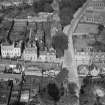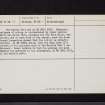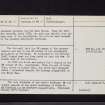Pricing Change
New pricing for orders of material from this site will come into place shortly. Charges for supply of digital images, digitisation on demand, prints and licensing will be altered.
Kirkcudbright, Meickle Yett And Town Wall
Gateway (Period Unassigned), Town Wall (Period Unassigned)
Site Name Kirkcudbright, Meickle Yett And Town Wall
Classification Gateway (Period Unassigned), Town Wall (Period Unassigned)
Alternative Name(s) Corby Slap; 128-30 High Street
Canmore ID 64075
Site Number NX65SE 35
NGR NX 6826 5081
Datum OSGB36 - NGR
Permalink http://canmore.org.uk/site/64075
- Council Dumfries And Galloway
- Parish Kirkcudbright
- Former Region Dumfries And Galloway
- Former District Stewartry
- Former County Kirkcudbrightshire
NX65SE 35 6826 5081 to 679 510.
(NX 6804 5109 - 6793 5090 and 6802 5085 - 6813 5078) Fortification (NR) (Remains of)
OS 6" map (1854)
Fosse (NR)
OS 25" map (1895)
See also NX65SE 108.
The town defences of 1547, when Kirkcudbright was besieged by the English under Sir Thomas Carleton, consisted principally, on the east, of a broad marshy creek extending south from the harbour (now occupied by St Mary's Street, St Cuthbert's Street and Church Grounds) to the Meickle Yett. Here a wall and ditch ran west to where the Academy stands (NX 6797 5084) and turned north to the riverside. The wall continued to a gate at the harbour. The south ditch was extant in 1841; the west ditch can still be traced intermittently.
The site of the Meickle Yett, rebuilt 1590, is marked by its two pivot stones, 6ft apart, in the pavement opposite the Old Bank House. When the Yett was removed, about 1780, the arch was rebuilt over the burn east of the churchyard; its pillars were re-used at the present churchyard entrance.
J Robison 1908; W Mackenzie 1841
The town wall left the SW corner of the present harbour and ran down to the NW corner of the churchyard wall,which it followed. It continued to the Meickle Yett, turned west and then north to join the Dee 14 chains west of the harbour. In 1850 the ditch was extant for 2 chains at the NW corner of the churchyard. From the end of Corby Slap, where it turned west, the ditch held stagnant water (culverted beneath the Academy playground) to the River Dee.
Name Book 1850
The only evidence of the town's defences is the slight remains of two short stretches of ditch at NX 6798 5104 and NX 6802 5107 respectively. Revised at 25".
The Meikle Yett was at NX 6826 5081. Robison's evidence of siting is contradicted by local opinion which maintains that, opposite the Old Bank House, two stones, one on each side of the street, mark the site. Ground inspection showed that the latter is probably correct. At NX 69083 51132, over the west side of a culvert is the supposed arch of the Meickle Yett (see Robison). Local opinion is that the gateway and arch forming the entrance to the churchyard, at NX 6902 5116, is the rebuilt yett.
Visited by OS (EGC) 22 February 1965
NX 682 507. Trial excavations were conducted in July 1993 at Corby Slap, 128-30 High Street, in advance of a housing development and within the angle of the SE corner of the medieval burgh defences. Two trenches, c1m by 6m, were machine excavated.
Trench A, aligned E to W, revealed the western side of a rubble dyke cut into mid-grey-brown clay subsoil, c0.5m below ground surface. The dyke appeared to be constructed of roughly hewn stone blocks and rounded beach cobbles bonded in a clay matrix.
Trench B, aligned N to S, revealed, c0.7m below ground surface, the northern side of a similar rubble dyke overlying an earlier back-filled ditch. This ditch appeared to cut through the subsoil into natural yellow-brown clay.
No direct dating evidence was recovered from either trench. The position of the walls appears to confirm the line of the walls as recorded in the historical record. No evidence of backland activity was encountered in either trench.
Sponsor: Historic Scotland.
J R MacKenzie 1993.




























